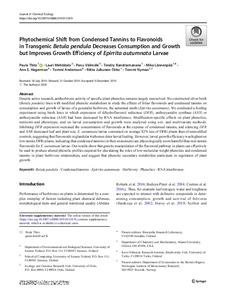Phytochemical shift from condensed tannins to flavonoids in transgenic Betula pendula decreases consumption and growth but improves growth efficiency of Epirrita autumnata larvae
Mika Lännenpää; Tommi Nyman; Tendry Randriamanana; Lauri Mehtätalo; Paula Thitz; Ann E. Hagerman; Tommi Andersson; Panu Välimäki; Riitta Julkunen-Tiitto
https://urn.fi/URN:NBN:fi-fe2021042823135
Tiivistelmä
Despite active research, antiherbivore activity of specific plant phenolics remains largely unresolved. We constructed silver birch (Betula pendula) lines with modified phenolic metabolism to study the effects of foliar flavonoids and condensed tannins on consumption and growth of larvae of a generalist herbivore, the autumnal moth (Epirrita autumnata). We conducted a feeding experiment using birch lines in which expression of dihydroflavonol reductase (DFR), anthocyanidin synthase (ANS) or anthocyanidin reductase (ANR) had been decreased by RNA interference. Modification-specific effects on plant phenolics, nutrients and phenotype, and on larval consumption and growth were analyzed using uni- and multivariate methods. Inhibiting DFR expression increased the concentration of flavonoids at the expense of condensed tannins, and silencing DFR and ANR decreased leaf and plant size. E. autumnata larvae consumed on average 82% less of DFRi plants than of unmodified controls, suggesting that flavonoids or glandular trichomes deter larval feeding. However, larval growth efficiency was highest on low-tannin DFRi plants, indicating that condensed tannins (or their monomers) are physiologically more harmful than non-tannin flavonoids for E. autumnata larvae. Our results show that genetic manipulation of the flavonoid pathway in plants can effectively be used to produce altered phenolic profiles required for elucidating the roles of low-molecular weight phenolics and condensed tannins in plant–herbivore relationships, and suggest that phenolic secondary metabolites participate in regulation of plant growth.
Kokoelmat
- Rinnakkaistallenteet [19250]
